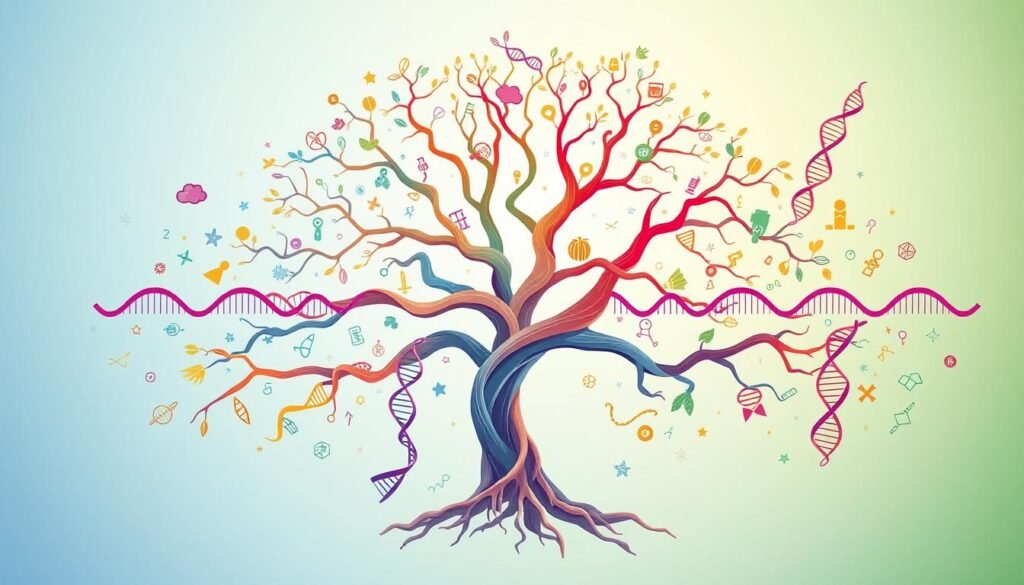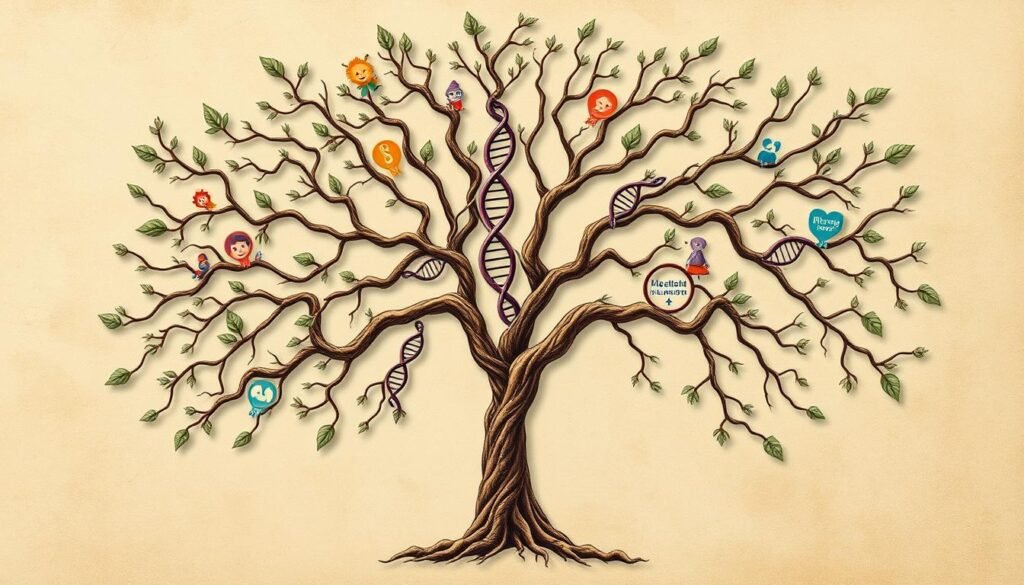Did you know heart disease, cancer, and diabetes cause 7 out of 10 deaths in the US? This fact shows how important genes and family history are in figuring out health risks. By looking into the genes from our ancestors, we can learn about our risk for inherited diseases.
Genetic predisposition plays a big role in our health. About 21,000 genes make up human DNA. Most diseases come from a mix of genetic and environmental factors. Small changes in many genes, not just one, often lead to diseases.
Knowing your family history is key for your health choices. Seeing patterns in your family’s health can show future risks. It’s critical to talk with family and track health histories. By understanding inherited conditions, we can make smarter health choices. This could involve regular checks and changing our lifestyle to avoid serious diseases. For more, see the research on genetic inheritance and family history.
Key Takeaways
- Genetic factors and family history are key in determining health risks.
- Diseases such as heart disease and diabetes are influenced by multiple genes.
- Family medical history can reveal patterns of hereditary diseases.
- Keeping an updated family health record can guide preventive measures.
- Environmental factors and lifestyle choices also play pivotal roles in disease development.
- Understanding one’s ancestry supports more informed health decisions.
The Role of Genetics in Health
Genetics is key in our health, affecting more than just traits. It influences our chance of getting different diseases. Getting to know how certain traits can lead to health issues is crucial.
Understanding Genetic Variation
We all have 46 chromosomes in pairs, making 23 sets. Out of these, 22 are autosomes and one pair is sex chromosomes. These decide if we are male or female. Each chromosome carries many genes. And for every gene, there are two alleles, one from each parent. How these alleles vary makes us unique. Some differences can lead to disorders.
Genetic changes can affect how proteins are made, leading to sickness. Sometimes, DNA gets methyl groups added to it. This can turn genes on or off, changing our health. This shows why knowing about genes and family health can help manage risks.
The Influence of Genetic Traits on Disease Risk
Our genes play a big role in how likely we are to get sick. Knowing our family’s health history helps spot risks for things like heart problems or cancer. Common issues like heart disease and diabetes can run in families. And some rare diseases are due to gene mutations.
Things like what we eat and air pollution also change disease risks. These changes in our environment can switch genes on or off. Having health histories for three generations helps us figure out our genetic risks. By changing how we live and getting regular check-ups, we can often avoid these risks. This helps us live healthier lives.
To learn more about how family health history affects chronic allergies and breathing, go to careyourlungs.com for tips on keeping your lungs healthy.
Genetic Factors and Family History
Knowing your family’s health history is key to understanding your own health risks. If your family has a history of certain diseases, you might be more likely to get them too. Doctors use this info to create prevention plans that work for you.
How Family History Affects Health Risks
Family history has a big role in determining the risk of hereditary diseases. Studies show that genetic factors cause 5% to 10% of all cancers. That’s why knowing your family’s health history is so important for spotting risks early, particularly for cancers like breast and ovarian.
Clinical guidelines suggest genetic testing if your family has a history of certain cancers. It helps catch risks early, offering a chance for timely treatment.
Identifying Patterns of Hereditary Diseases
Some families have common patterns of diseases, and that can tell us a lot about our health risks. For instance, heart disease can run in families due to shared genes. These genes might increase the risk of high cholesterol and severe heart rhythms.
If heart disease appeared early in your family, it’s smart to get checked out early. This is especially true if your family members had heart problems before 60.
Understanding these patterns can make you more aware of your health risks. Linking family history to genetic testing helps doctors give better advice and care.

| Health Risk Factor | Familial Link | Preventive Measures |
|---|---|---|
| Cancer | Inherited changes (5%-10%) | Genetic testing, early screenings |
| Heart Disease | Family history of heart conditions | Early health checks, lifestyle modifications |
| Diabetes | Genetic predisposition | Diet, exercise, regular check-ups |
Hereditary Diseases: A Closer Look
Hereditary diseases cover many disorders that can seriously affect health. Some conditions are passed down in families. It’s important to know how common they are and the risks they bring. Learning about these diseases helps with early detection, which is good for both individuals and their families.
Common Hereditary Disorders
Many hereditary disorders impact people all over the world. Some well-known ones are:
- Cystic fibrosis
- Sickle cell anemia
- Familial hypercholesterolemia
- Huntington’s disease
- Hemophilia
These genetic disorders usually start from gene changes passed through families. This can cause specific symptoms and health issues. For example, the BRCA1 gene change greatly raises the chance of getting breast cancer. People with this gene change have an up to 87% risk, much higher than the 12% risk in the general population.
Identifying the Signs of Familial Risk
It’s key to notice signs of risk in the family early. These signs can be:
- How early family members got the disease
- How severe the symptoms were in relatives
- The family history of diseases like diabetes or some cancers
For instance, having a close relative with type 2 diabetes triples your chance of getting it. Genetic tests and regular checks can lower the risk of these diseases. Talking about family health history with doctors is very important.

Knowing about hereditary conditions helps families make smart health decisions. It shows why it’s vital to get genetic counseling to understand future risks.
| Disorder | Prevalence | Key Genetic Mutation |
|---|---|---|
| Cystic Fibrosis | 1 in 3,500 births | CFTR gene |
| Sickle Cell Anemia | 1 in 365 African American births | HBB gene |
| Familial Hypercholesterolemia | 1 in 250 births | LDLR gene |
| Huntington’s Disease | 1 in 10,000 births | HTT gene |
| Hemophilia | 1 in 5,000 male births | F8 or F9 gene |
Genetic Predisposition and Disease Risk
Genetic predisposition plays a key role in our health by affecting our chance of getting certain diseases. It helps us make smart choices for our health. Various genetic disorders show how mutations can raise our health risks.
Understanding Genetic Susceptibility
Genetic susceptibility means having a higher chance of disease due to genes from our family. Diseases like cystic fibrosis or sickle cell anemia come from changes in just one gene. If you carry this gene change, you’re more likely to get the disease.
Polygenic vs. Monogenic Disorders
Polygenic disorders, unlike monogenic, involve many genes. These include heart disease and diabetes. The risk varies greatly from person to person based on their genes.
Studies show that good genes can lessen risks from dangerous single-gene changes. New tools are mixing single and multiple gene factors to help people understand and manage their health better.

Importance of Family Medical History
Knowing your family’s medical history is very important. It helps estimate health risks linked to your genes. By collecting information about your relatives, you give your doctor useful insights. They can then suggest the right screenings and preventive actions. A detailed family medical history includes info on three generations of relatives. This info is crucial to identify possible inherited health issues.
What to Include in a Family Medical History
Your family medical history needs several key pieces of information. It should outline health conditions and when they started. Important details include:
- Chronic diseases in family members, like cancer, heart disease, and diabetes.
- Age when family members were diagnosed with these conditions.
- Their relationship to you (e.g., parents, siblings, grandparents).
- Lifestyle habits such as smoking, alcohol use, and exercise routines.
Gathering this information helps spot potential genetic risks. It helps doctors see connections between your family’s history and steps to take for your health.
Examining Three Generations of Health Data
Looking at health data from three generations gives more insight into family health trends. Studies show having a relative with a chronic disease might increase your risk. If a close relative has a condition, your risk might double.
Family health talks are important during doctor visits. These short discussions can shed light on how your family’s health affects you. They lead to advice on lifestyle changes and important screening tests. This can help improve your health over time, especially if your family’s history is a concern.
Inherited Conditions and Their Impact
Inherited conditions deeply influence personal and family health. It’s key to know how genetic disorders run in families. This knowledge helps foresee health issues generations might face. Different inheritance methods determine if a disease will pass on, and looking into genetic ancestry enlightens us about disease risks.
Familial Patterns of Genetic Disorders
Disorders follow specific inheritance patterns, affecting family health differently. Look at these examples:
- Autosomal dominant disorders need only one mutated gene to show up. Diseases like Huntington’s and Marfan syndrome are examples. There’s a 50% chance these can pass to children from a parent with the mutation.
- Autosomal recessive disorders require both genes to be altered. Conditions like cystic fibrosis and sickle cell anemia work this way. Carriers might not show symptoms but have a 25% chance of passing these on if both parents carry the gene.
- Then, we have X chromosome linked disorders, which could be dominant or recessive. Fragile X syndrome is an example of X-linked dominant. Hemophilia is X-linked recessive and mainly affects boys.
Changes in chromosome number or structure can lead to disorders. Take Down syndrome, which involves an extra chromosome 21, as an example.
How Genetic Ancestry Influences Health
Looking into genetic ancestry helps us grasp inherited conditions and susceptibilities. This insight urges us to make better health decisions, like getting genetic tests or changing our lifestyle. It aids in assessing the risk for health issues like heart disease and diabetes. Ancestry studies offer crucial information for our health path.
Understanding inherited conditions influences public health planning too. With polygenic risk scores, we can better estimate disease risks. This need broadens the scope for genetic research. As healthcare shifts, wider access to genetic info will support smarter health choices in families.
To fully grasp how inheritance works and its effects, visit this detailed resource.
Congenital Disorders: Genetic and Environmental Interactions
It’s key to understand how genetic conditions and environment interact to identify congenital disorders. Across the globe, over 7,000 types of birth defects impact more than 7.9 million people yearly. These conditions result from both genetic anomalies and external factors.
Identifying Congenital Anomalies in Families
Families can spot congenital disorder patterns by studying their health history. In the U.S., 3% of babies are born with significant birth defects annually, per CDC data. This underscores the need for genetic testing and awareness in families with health issue histories. Despite advances, about 80% of birth defects lack a known cause. This points to the need for an in-depth understanding of genetic influences and congenital anomaly detection for better intervention and support.
Environmental Factors Affecting Genetic Conditions
Environmental influences play a big role in genetic conditions, often in complicated ways. For every birth defect, genetic and environmental factors interact. Teratogens, for example, can disrupt development, leading to severe issues like heart and neural tube defects. Given 240,000 newborns die each month from congenital disorders, and 170,000 children aged 1 month to 5 years annually, prevention is crucial. Understanding environmental dangers and getting genetic testing can help protect children’s health. For more on this, visit this source.
| Type of Birth Defect | Global Incidence | Risk Factors |
|---|---|---|
| Heart Defects | 1 in 100 live births | Genetic factors, maternal diabetes |
| Neural Tube Defects | 0.5-1 per 1,000 live births | Folic acid deficiency, obesity |
| Orofacial Clefts | 1 in 1,000 live births | Smoking, certain medications |
| Limb Defects | 1 in 3,000 live births | Exposure to teratogenic drugs |
Realizing how crucial both genetic conditions and environmental factors are helps create better health strategies. Knowing how these elements interplay can lead to improved prevention and care for at-risk families and individuals.
Understanding Multigenerational Traits
Multigenerational traits are key in understanding how certain features pass through families. They show how genes and environment work together, changing how we look at family health. This knowledge helps predict health outcomes and tailor health care to our genetic backgrounds.
Traits Passed Down Through Generations
Many things like personality, health, and life choices can trace back to our ancestors. Studies show that these traits, including:
- Personality and psychological well-being
- Educational attainment and Socioeconomic Status (SES)
- Body Mass Index (BMI)
- Health conditions like celiac disease
Celiac disease, for example, often runs in families, pointing to a genetic cause. Research has helped us see how this condition is shared across generations. The rising popularity of gluten-free diets also shows how culture adapts to these genetic issues.
Gene-Environment Interactions in Multigenerational Traits
The way genes and the environment interact affects traits passed through families. The environment can change traits in ways that last for generations. Things like chemicals, climate, and how we are raised can influence our genes and actions. Animal studies have revealed surprising ways these traits can be passed on, suggesting RNA plays a key role.
This understanding helps us see how behavior and surroundings can reinforce family traits. Parenting styles, which include how warm and responsive a parent is, greatly affect children. Modern studies help clear up any confusion from previous ones, giving us a better view of how parenting passes down traits.
| Characteristic | Multigenerational Influence |
|---|---|
| Personality | Passed down through familial interactions and upbringing |
| Educational Attainment | Linked with familial support and cultural values |
| Body Mass Index (BMI) | Influenced by both genetics and dietary patterns within families |
| Celiac Disease | Evidence of familial clustering and genetic factors |
| Parenting Styles | Transmitted behaviors impacting child development and relationships |
Conclusion
The link between genetics and family history is key to knowing our health risks, especially with hereditary diseases. Knowing our genetic makeup helps us spot potential health problems early. It also encourages us to take steps to prevent them. For example, a family history of heart disease raises the risk of similar problems. So, it’s vital to get regular health checks and live healthily.
Though inherited conditions come from our genes and habits, we can reduce our risk by making good choices. This includes staying at a healthy weight and exercising regularly. Family history plays a big role in the chance of getting diseases. That’s why it’s crucial to know our family’s health history well. This info helps create prevention plans that work for us.
Being aware of our genetic risks helps us manage our family health history better. This leads to better health overall. By looking at our genetics and family history, we can take better care of our health. This means making smart choices about how we live and the care we get.